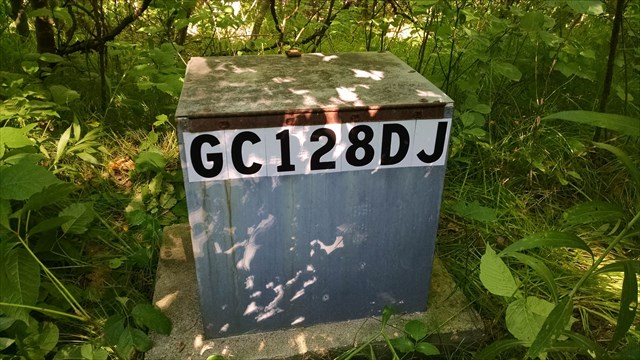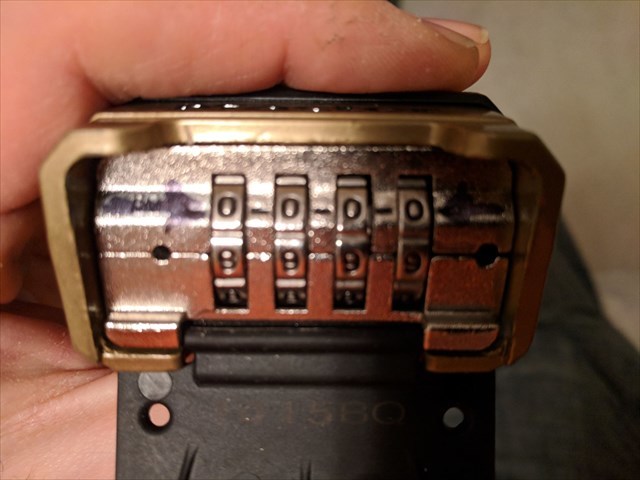Watertown History Cache Mystery Cache
-
Difficulty:
-

-
Terrain:
-

Size:  (large)
(large)
Please note Use of geocaching.com services is subject to the terms and conditions
in our disclaimer.
You will need to read the cache page and learn a bit of the history of Watertown in order to get the coordinates and combination to the cache container.
Cache Is Not At Above Coordinates!
In order to locate this cache, you must first learn some history of the area.
The actual cache is located within two miles of the above coordinates, and on private property (with permission, of course). |
The Beginning
Watertown was settled in 1856 and large portions of the town were filled in the following year. Most of the land where the town currently is located was owned by Caleb Lewis, which is why the traditional "Main St." is called "Lewis St." instead. Originally the settlement was slated to be named "Rapid Waters", which comes from the Dakota, "Ni' kaduza." It was believed that Rapid Waters would be confused too easily with Little Rapids and that mail would get misrouted. Caleb Lewis grew up in Watertown, New York, and the town is near several lakes and had a "mighty stream" named the Crow running through the area, so the town was officially named the village of Watertown. The naming was made official on April 13, 1858, with an election held in Eli F. Lewis' general store. Eli was also made the acting postmaster, with mail sent and received in his store.
The first couple years that people were settling into the area also unfortunately marked the first death. The son of Thomson drowned in Oak Lake in the summer of 1857. To offset that news, Celestine Kohler had himself a baby boy on January 3, 1857, which he named after himself. Also, the first wedding in Watertown happened on Christmas day, 1857, between P.O. Johnson and Josephine H. Brown.
The village was incorporated February 26, 1877. Within four years, the town had three general stores, one hardware store, a plow factory, a bell foundry, a grist mil, a saw mill, and a brewery. There was also a fire department with engines, three hotels, three churches, two secret orders, and other associations. It also had two drug stores, two confectioneries, two meat markets, three wagon shops, and four shoe shops.
The Mills
Back in the day, Watertown was best known for its grist (grain) and saw mills. The village's first saw mill was built on the east side of the river in the fall of 1856. Mill Street denotes the location of Watertown's earliest mills. Soon after, Eli F. Lewis and Isaac I. Lewis purchased the building, disassembled it, and rebuilt it on the west side of the Crow in 1859. During the move, the Lewis's added a grist mill to the structure, which could mill 40 to 50 barrels a day. People from over 50 miles away would come to the village to buy their ground flour. A horse-drawn wagon travels at 2.5 miles per hour, making the round trip about 40 hours of riding.
In 1865, M.F. Lineau and Mr. Dressler purchased the mills, known then as Union Mill. Dressler sold his interest in the mills to Charles H. Lineau, brother of M.F. Lineau in 1870. Unfortunately, the joint mills caught fire and burned down in 1874. C.H. Lineau sold his interest in the mills to George Roeschiese and the mills were rebuilt the following year for a cost of $8,000 and could produce 60 barrels per day. If you apply inflation, the mill would cost $145,000 today.
Since the mills were so close to the river, a dam was constructed in 1878 for $6,000 ($116,000 today). When available, water power was used in addition to steam power. This arrangement only lasted for two years, for in 1880 the mills burned down yet again. The saw mill and grist mill were separated to prevent similar tragedies, and the Watertown Roller Mills were redesigned by M.F. Lineau and built by the Cooperative Business Men and Farmers Association. The new saw mill was built for $2,000 ($44,000 today) and had a capacity of 10,000 feet per day. The newly redesigned grist mill cost $8,000 ($176,000 today) and could now produce 75 barrels per day.
For several years, the mill worked well, but the millrace eventually broke out. Water power was no longer an option and the Watertown Mills ran solely on steam power. The grist mill burned to the ground on December 20, 1920. A new mill was built in less than a year and was under the control of the Watertown Coop Grain and Fuel Association. Luckily, this one was in operation for many years.
The Other Businesses
Watertown had a cannery, built by Duluth businessmen in 1918, who joined together as Gopher State Canneries, Inc. In the first "pack" year, 500 acres and 51 employees produced 30,000 cases of corn. Gopher State Canneries became associated with the Minnesota Valley Canning Company in 1927, leased to them in 1934, then finally sold in 1938. The Minnesota Valley Canning Company, who later became Green Giant, operated the factory through the 1950's.
Cottage Hospital was built just after the turn of the century on Angel Street by Dr. Hany Halgren, son of the town's first druggist and a prominent local physician. Later, the Watertown Community Hospital was built and this building was divided into apartments and extensively altered since its construction.
The War
In 1862, $3,000 ($68,500 today) was raised to pay bounties to soldiers; $259 ($5,800) per man. The next year, $900 ($20,500) bonds were issued to fill the quota of the town, allowing $300 ($6,800) to each man who enlisted. The population of all males, including little boys and old grandfathers, in the township of Watertown was 328. The number of men that were eligible, who were between 18 and 45, was 103. Before 1865, 68 signed up to fight in the war. As of 1865, the rest of the eligible males enlisted to fight in the war.
The Quiz
There had to be an end to the history lesson. Select the correct answer for each question and add up the numbers given. "A" and "B" will be three digit numbers and should be used in this set of coordinates: N 44° 5A.AA6, W 093 5B.BB0. The cache container has a lock that has a four digit combination, which is the "C" number. Before heading out to the cache, you can use the coordinate checker to confirm your coordinates, which should also ensure you have the right combination for the lock.
- There was a county-wide plague of grasshoppers in 1879. By that year, how many times was the mill built?
- Once: A = 41, B = 93, C = 347
- Twice: A = 247, B = 12, C = 2694
- Three times: A = 375, B = 28, C = 2010
- Four times: A = 74, B = 42, C = 3241
- Mill Street in Watertown is on the east side of the river and was named because of the number of mills on the road. When the mill was named Union Mill, what side of the river was it on?
- West: A = 75, B = 43, C = 1597
- East: A = 106, B = 08, C = 2605
- One of the hotels in 1881 conducted a stage line to Delano. The route was a little over 7.5 miles. How long would that take in hours for a horse-drawn wagon?
- One: A = 269, B = 06, C = 776
- Two: A = 34, B = 28, C = 952
- Three: A = 67, B = 12, C = 3454
- Four: A = 69, B = 76, C = 3403
- There were two secret societies in Watertown. Which one was NOT one of the two?
- Druids (Franklin Grove No. 2 of United Ancient Order of Druids): A = 99, B = 24, C = 2705
- Freemasons (Watertown Lodge No. 50 of Ancient Free and Accepted Masons): A = 93, B = 57, C = 3157
- Geocachers (The Wander-In-Circles Clan of the Turned Leaf): A = 47, B = 23, C = 921
- How many soldiers did Watertown recruit for the war?
- 328: A = 80, B = 95, C = 796
- 103: A = 85, B = 46, C = 589
- 68: A = 115, B = 54, C = 1863
The Cache
You are looking for this: 
The Sources
I would like to thank the Carver County Historical Society for their help with my research. The curator did everything for me except actually turn the pages in the book that I was reading. My time spent in this project might be considerable, but their help really got the research moving at a great pace.
- Carver County: A Guide To Its Historic and Prehistoric Places, Ted Lofstrom and Lynne VanBrocklin Spaeth, 1978
- History of the Minnesota Valley, Carver County Historical Society, (maybe 1881)
- Compendium of History & Biography of Carver & Hennepin Counties, Holcombe and Bingham, 1915
- History of Watertown, City of Watertown Web Page, retrieved 2007
- Our Communities: A Walk Back Through Time (Watertown), Carver County Historical Society, retrieved 2007
- 2005 City of Watertown Parks, Trails, and Open Space Master Plan (47 megs), Urban and Regional Studies Institute, Minnesota State University, Mankato
- Watertown Township Map, Carver County
- Carver County Ghost Towns Map, Carver County Historical Society, retrieved 2007
- Inflation Calculator, The
A Note On The Combination
When you get to the geocache, you will need to be careful when entering the combination. There are guide marks on the lock, but they are at the top of the lock. For instance, the lock in this photo is dialed in as 0000.

Additional Hints
(Decrypt)
Ivfvoyr sebz lbhe pne hagvy gur terrare zbaguf. Ybbx abegujrfg sebz gur pybfrfg ebnq. Qbhoyr purpx pbbeqvangrf jvgu gur purpxre orsber tbvat fb lbh pna nyfb pbasvez gur evtug pbzovangvba.